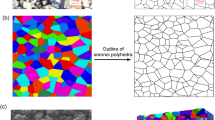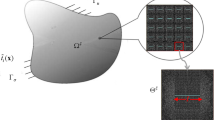Abstract
A two-dimensional boundary element code, based on the displacement discontinuity method is used to simulate a confined compression test. The method takes account of the granular nature of the rock and of the presence of pre-existing defects. Fracture propagation is thought to depend, amongst other factors, on the crack orientation, the residual friction angle, the dilation angle, and the confining pressure. To obtain a more precise understanding of the influence of these properties on the crack growth process, their influence on the normal stress and the excess shear stress on potential fracture planes ahead of the crack tip is investigated for a single crack configuration. The orientation of the potential fracture planes proves to be the most important parameter determining fracture growth. A series of numerical experiments is carried out to determine the influence of the tessellation pattern used to represent the granular nature of the rock. Both the influence of the type of tessellation and the tessellation density are evaluated, and reasons for the differences in behaviour are presented. The results of the simulations with the Delaunay and a Voronoi tessellation with internal fracture paths compare well with the fracture pattern obtained in laboratory tests. The pre-peak non-linearity in the stress-strain response obtained with the Voronoi tessellation and the post-peak strain softening obtained with the Delaunay tessellation are combined in one model. For that purpose, a Voronoi tessellation with internal fracture paths is used, whereby the properties of the elements of the polygons and of the internal fracture paths are assigned different values. The role that is played by shear failure and the influence of dilation on the localisation process is determined by means of some further numerical experiments. It is shown that at the scale, at which the material is modelled, shear failure is required for a shear band to develop.
Similar content being viewed by others
References
Arthur, J.R.F., Dunstan, T., Al-Ani, Q.A.J.L. and Assadi, A. (1977). Plastic deformation and failure in granular media. Géotechnique 27, 53-74.
Ashby, M.F. and Hallam, S.D. (1985). The failure of brittle solids containing small cracks under compressive states. Acta Metallurgica 34, 497-510.
Bathurst, R.G.C. (1991). Carbonate sediments and their diagenesis, Elsevier, Amsterdam. 620 pp.
Batzle, M.L., Simmons, G. and Siegfried, R.W. (1980). Microcrack closure under stress: direct observation. Journal of Geophysical Research 85, 7072-7090.
Blair, S.C. and Cook, N.G.W. (1998). Analysis of compressive fracture in rock using statistical techniques: Part I. A non-linear rule-based model. International Journal of Rock Mechanics and Mining Sciences 35, 837-848.
Bobet, A. and Einstein, H.H. (1998a). Fracture coalescence in rock-type materials under uniaxial and biaxial compression. International Journal of Rock Mechanics and Mining Sciences 35, 863-888.
Bobet, A. and Einstein, H.H. (1998b). Numerical modelling of fracture coalescence in a model rock material. International Journal of Fracture 92, 221-252.
Brady, B.H.G. and Brown, E.T. (1993). Rock Mechanics for Underground Mining, Chapman & Hall, London, 571 pp.
Chen, W.F. and Han, D.J. (1988). Plasticity for Structural Engineers, Springer-Verlag, New York, 250 pp.
Chen, Y, Nishiyama, T., Kusuda, H., Kita, H. and Sato, T. (1999). Correlation between microcrack distribution patterns and granitic rock splitting planes. International Journal of Rock Mechanics and Mining Sciences 36, 535-541.
Crawford, A.M. and Curran, J.H. (1982). Higher-order functional variation displacement discontinuity elements. International Journal of Rock Mechanics and Mining Sciences 19, 143-148.
Crouch, S.L. and Starfield, A.M. (1983). Boundary Elements in Solid Mechanics, Allen & Unwin, London, 606 pp.
Finney, J.L. (1979). A procedure for the construction of Voronoi polyhedra. Journal of Computational Physics 32, 137-143.
Hallbauer, D.K., Wagner, H. and Cook, N.G.W. (1973). Some observations concerning the microscopic and mechanical behaviour of quartzite specimens in stiff, triaxial compression tests. International Journal of Rock Mechanics and Mining Sciences 10, 713-726.
Handley, M.F. (1995). An investigation into the constitutive behaviour of brittle granular media by numerical experiment, Ph.D. thesis, Univ. Minnesota, 314 pp.
Horii, H. and Nemat-Nasser, S. (1985). Compression induced microcrack growth in brittle solids: Axial splitting and shear failure. Journal of Geophysical Research 90, 3105-3125.
Jaeger, J.C. and Cook, N.G.W. (1979). Fundamentals of Rock Mechanics, Chapman and Hall, London, 593 pp.
Kranz, R.L. (1979a). Crack growth and development during creep of Barre granite. International Journal of Rock Mechanics and Mining Sciences 16, 23-36.
Kranz, R.L. (1979b). Crack-crack and crack-pore interactions in stressed granite. International Journal of Rock Mechanics and Mining Sciences 16, 37-47.
Kožušnikova, A. and Mare¡ckova, K. (1999). Analysis of rock failure after triaxial testing. International Journal of Rock Mechanics and Mining Sciences 36, 243-251.
Kuijpers, J.S. and Napier, J.A.L. (1996). Effective growth rules for macrofracture simulation in brittle rock under compression. Eurock'96 (edited by Barla, G.), Balkema, Rotterdam, 469-479.
Lawn, B. (1993). Fracture of Brittle Solids, Cambridge University Press, Cambridge, 378 pp.
Li, C., Prikryl, R. and Nordlund, E. (1998). The stress-strain behaviour of rock material related to fracture under compression. Engineering Geology 49, 293-302.
Malan, D.F. and Napier, J.A.L. (1995). Computer modelling of granular material microfracturing. Tectonophysics 248, 21-37.
Napier, J.A.L. (1990). Modelling of fracturing near deep level gold mine excavations using a displacement discontinuity approach. Proceedings of the second international conference on mechanics of jointed and faulted rock (edited by Rossmanith, H.-P.), Balkema, Rotterdam, 709-715.
Napier, J.A.L. and Hildyard, M.W. (1992). Simulation of fracture growth around openings in highly stressed brittle rock. Journal of the South African Institute of Mining and Metallurgy 92, 159-168.
Napier, J.A.L. and Peirce, A.P. (1995). Simulation of extensive fracture formation and interaction in brittle materials. Proceedings of the second international conference on mechanics of jointed and faulted rock (edited by Rossmanith, H.-P.), Balkema, Rotterdam, 63-74.
Napier, J.A.L. and Malan, D.F. (1997). A viscoplastic discontinuum model of time-dependent fracture and seismicity effects in brittle rock. International Journal of Rock Mechanics and Mining Sciences 34, 1075-1089.
Napier, J.A.L., Daehnke, A., Dede, T., Hildyard, M.W., Kuijpers, J.S., Malan, D.F., Sellers, E.J. and Turner, P.A. (1997). Quantification of stope fracture zone behaviour in deep level gold mines. Journal of the South African Institute of Mining and Metallurgy 97, 119-134.
Peirce, A.P. and Napier, J.A.L. 1995. A spectral multipole method for efficient solution of large-scale boundary element models in elastostatics. International Journal for Numerical Methods in Engineering 38, 4009-4034.
Peng, S.S. and Johnson, A.M. (1972). Crack growth and faulting in cylindrical specimens of Chelmsford granite. International Journal of Rock Mechanics and Mining Sciences 9, 37-86.
Reeves, M.J. (1985). Rock surface roughness and frictional strength. International Journal of Rock Mechanics and Mining Sciences 22, 429-442.
Sellers, E. and Napier, J. (1997). A comparative investigation of micro-flaw models for the simulation of brittle fracture in rock. Computational Mechanics 20, 164-169.
Sprunt, E.S. and Brace, W.F. (1974). Direct observations of microcavities in crystalline rocks. International Journal of Rock Mechanics and Mining Sciences 11, 139-150.
Vermeer, P.A. (1990). The orientation of shear bands in biaxial tests. Géotechnique 40, 223-236.
Walsh, J.B. (1965a). The effect of cracks on the uniaxial elastic compression of rocks. Journal of Geophysical Research 70, 399-411.
Walsh, J.B. (1965b). The effect of cracks on the compressibility of rock. Journal of Geophysical Research 70, 381-389.
Wong, R.H.C. and Chau, K.T. (1998). Crack coalescence in a rock-like material containing two cracks. International Journal of Rock Mechanics and Mining Sciences 35, 147-164.
Wong, T.-F. (1982). Micromechanics of faulting in Westerley granite. International Journal of Rock Mechanics and Mining Sciences 19, 49-64.
Author information
Authors and Affiliations
Rights and permissions
About this article
Cite this article
Van de Steen, B., Vervoort, A. & Napier, J. Numerical modelling of fracture initiation and propagation in biaxial tests on rock samples. International Journal of Fracture 108, 165–191 (2001). https://doi.org/10.1023/A:1007697120530
Issue Date:
DOI: https://doi.org/10.1023/A:1007697120530




